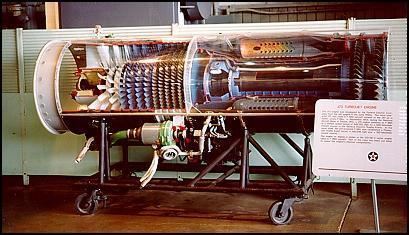 | ||
The General Electric J73 turbojet was developed by General Electric from the earlier J47 engine. Its original USAF designation was J47-21, but with innovative features including variable inlet guide vanes, double-shell (inner and outer) combustor case and 50% greater airflow was redesignated the J73. It was only used in the North American F-86H.
Contents
Design and Development
An engine, uprated from the J47, was required for the F-86H. The mass flow was increased by relocating accessories from the centre of the compressor inlet to the underside of the engine. This allowed a reduction in blade hub diameter, which together with an increase in tip diameter, gave a bigger area for air to enter the compressor. The area through the combustion chambers also had to be increased. This was done by replacing the multiple individual chambers with a single annular casing with individual flame tubes or cans known as cannular.
The pressure ratio was increased and variable inlet guide vanes fitted to prevent low-RPM problems (rotating stall/blade flutter) with the higher design pressure ratio. A 2-stage turbine was required.
A low boost (10% at take-off) afterburner was fitted. It was known as a tailpipe augmentation (TPA) system.
Variants
Applications
Specifications (J73-GE-5)
Data from Flight.
